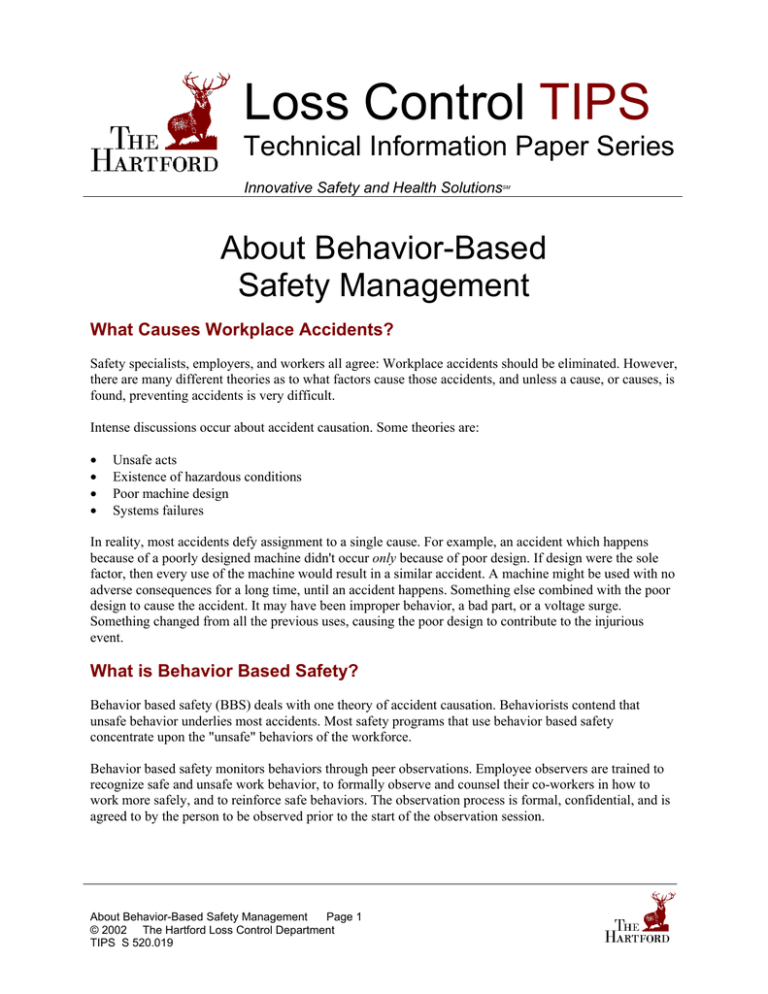Loss Control TIPS
advertisement

Loss Control TIPS Technical Information Paper Series Innovative Safety and Health Solutions SM About Behavior-Based Safety Management What Causes Workplace Accidents? Safety specialists, employers, and workers all agree: Workplace accidents should be eliminated. However, there are many different theories as to what factors cause those accidents, and unless a cause, or causes, is found, preventing accidents is very difficult. Intense discussions occur about accident causation. Some theories are: • • • • Unsafe acts Existence of hazardous conditions Poor machine design Systems failures In reality, most accidents defy assignment to a single cause. For example, an accident which happens because of a poorly designed machine didn't occur only because of poor design. If design were the sole factor, then every use of the machine would result in a similar accident. A machine might be used with no adverse consequences for a long time, until an accident happens. Something else combined with the poor design to cause the accident. It may have been improper behavior, a bad part, or a voltage surge. Something changed from all the previous uses, causing the poor design to contribute to the injurious event. What is Behavior Based Safety? Behavior based safety (BBS) deals with one theory of accident causation. Behaviorists contend that unsafe behavior underlies most accidents. Most safety programs that use behavior based safety concentrate upon the "unsafe" behaviors of the workforce. Behavior based safety monitors behaviors through peer observations. Employee observers are trained to recognize safe and unsafe work behavior, to formally observe and counsel their co-workers in how to work more safely, and to reinforce safe behaviors. The observation process is formal, confidential, and is agreed to by the person to be observed prior to the start of the observation session. About Behavior-Based Safety Management Page 1 © 2002 The Hartford Loss Control Department TIPS S 520.019 The purpose of BBS is to revise the safety culture of a company, and to reorient employee's safety attitudes. A behavior based safety program concentrates upon workers who are the most likely to be injured if they make unwise decisions or if they fail to think through what they do and how they do it. How does Behavior Based Safety Fit into Your Company's Culture? Can BBS improve safety and productivity at your company? Will it be worth the investment? Naturally, you will expect to reduce accidents, and also to help your people improve their value to the company. The improvements may be qualitative , such as better morale, or quantifiable, such as improved production. Expenditure without return is a luxury very few organizations can tolerate. Returns on a behavior based safety program can be quite impressive, if four conditions are met: 1. Management commitment is unwavering. The company culture, top to bottom, must be supportive. 2. Hazards are designed out of equipment and processes. For example, if a press is modified to use an automatic feed rather than a manual feed, the point of operation can be almost completely enclosed, resulting in far less concern about an operator reaching into the die. Do not expect behavior based safety to overcome poor design. 3. Management decision-making routinely includes and uses input from all people in the operation. The success of job observations requires open discussion between the employees and management. With an interactive infrastructure firmly entrenched in the company's culture, BBS can reach its full potential. 4. Adequate time and resources are allocated to the program to properly train people initially and to perform the routine job observations. Observations are the heart of the program. Training observers becomes a continuing investment as turnovers occur and as additional observers are brought on line. Adequate time for training and job observations will help to create the most effective program possible. It's impossible to overemphasize that behavior based safety is only one aspect of an overall safety process. It should never be used as a stand-alone safety program. Behavior based safety places most of the responsibility for individual safety on the workers and observers. Individual observations are kept confidential and are accessible only to specific workers supporting the program. Thus, a major requirement of the program is trust between managers, supervisors, and employees. Behavior Based Safety, Or Not? Implementing a BBS program is a major decision, both in terms of money, and in time. Behavior based safety revolves around the unsafe acts theory. The BBS program requires considerable time, effort, and expense. This includes time for initial and continuing training; time to conduct, review, and compile observations; and time for discussion of the various ideas/problems between managers, supervisors, and workers. An honest calculation of the costs must include, at the least, salary and benefits, lost production time, and any overtime which may be necessary. About Behavior-Based Safety Management Page 2 © 2002 The Hartford Loss Control Department TIPS S 520.019 A behavior based safety program will probably include: An introductory and educational session(s) for managers and supervisors A "rollout announcement" session for all people in the operation Development of a checklist of “safe behaviors” for the observers to use Initial and follow-up observer training Continuing training for new observers New employee training Serious questions must be asked—and answered honestly—prior to deciding whether or not to use a BBS program. Are accidents and injuries at my worksite frequent or rare? The severity and frequency of accidents and injuries at each organization are different. Although "zero accidents" is everyone's desire, risk-free work places do not exist. No activity can be made riskfree. Where there is risk, untoward outcomes are possible. If the level of losses is low, perhaps a BBS program is more extensive and expensive than is necessary. Further lowering of could probably be accomplished with a focused program which would be far less costly than a BBS program. If the level of losses is higher, or is trending in the wrong direction, then a BBS program may be of benefit. Are most of the accidents and injuries related to behavior? Whose behavior — management's, engineer's, supervisor's, worker's, vendor's, and/or customer's? If you aren't sure of the answer to whose behavior is responsible for the losses, perhaps you should stop here until you find the answer. As mentioned earlier, most BBS programs concentrate upon the worker's "behavior." Before valuable resources are directed toward that group, be absolutely certain that you know where the safety emphasis is most needed. Are there alternative safety procedures or processes which do a better job than a BBS program? Alternatives run the gamut from uncomplicated inspection programs to sophisticated systems applications. A behavior based safety program is just one alternative. Ultimately, whatever safety program you choose should become a process — an integral part of your operation — rather than an entity unto itself. If you have already integrated safety into your production and quality processes, you probably don't need a new safety program. You may only need to fine tune what is already in place. Linking Behavior Based Safety and The Hartford's Loss Control Philosophy The Hartford’s Loss Control Department provides resources and training which can help establish essential linkages between BBS and other critical safety components, such as ergonomics and machine safeguarding. In addition to assisting with behavior based safety programs at your facility, The Hartford’s Loss Control Consultants can help you study your operations to discover the root causes of the accidents, About Behavior-Based Safety Management Page 3 © 2002 The Hartford Loss Control Department TIPS S 520.019 provide assistance in finding system modifications which should help improve productivity and quality, while reducing losses. Example: A BBS observer identifies an operator's inappropriate lifting technique. The observer will counsel the operator about proper lifting techniques. This addresses the operator's technique, but fails to address the system components requiring the lift. The Hartford's training programs can help the employer, and the observer, broaden the scope of the observation by teaching how to identify the system components which cause the lift to be necessary. This process can identify unnecessary tasks. Then, using a solution finding technique such as brainstorming, system changes can be discovered which should minimize or eliminate the exposure from the work place. Example: The observer notices an individual using a machine from which the guard has been removed. The observation process identifies an unsafe behavior, which is discussed with the operators, emphasizing the importance of keeping safeguards in place at all times. The Hartford's Loss Control professionals can enhance this process by teaching operators, supervisors, maintenance people, and engineers to question why the guard was removed, and why it was left off. Once this is discovered, possible alternatives can be explored. The purpose is to eliminate the need for a guard, if possible, by system modification. If not possible, then designing the guard to be fully functional, but "user friendly," and "tamper resistant," would be the next highest priority. Given the expenditures associated with implementing a complete behavior based safety process, many companies hesitate to make this level of investment. However, if you are considering behavioral based safety as a supplement to your safety program, or have already implemented BBS, The Hartford’s Loss Control will be happy to work with you to help obtain maximum benefit for your investment. For more information, contact your local Hartford agent or your Hartford Loss Control Consultant. Visit The Hartford’s Loss Control web site at http://www.thehartford.com/corporate/losscontrol/ This document is provided for information purposes only. It is not intended to be a substitute for individual legal counsel or advice on issues discussed within. Readers seeking resolution of specific legal issues or business concerns related to the captioned topic should consult their attorneys and/or insurance representatives. About Behavior-Based Safety Management Page 4 © 2002 The Hartford Loss Control Department TIPS S 520.019

